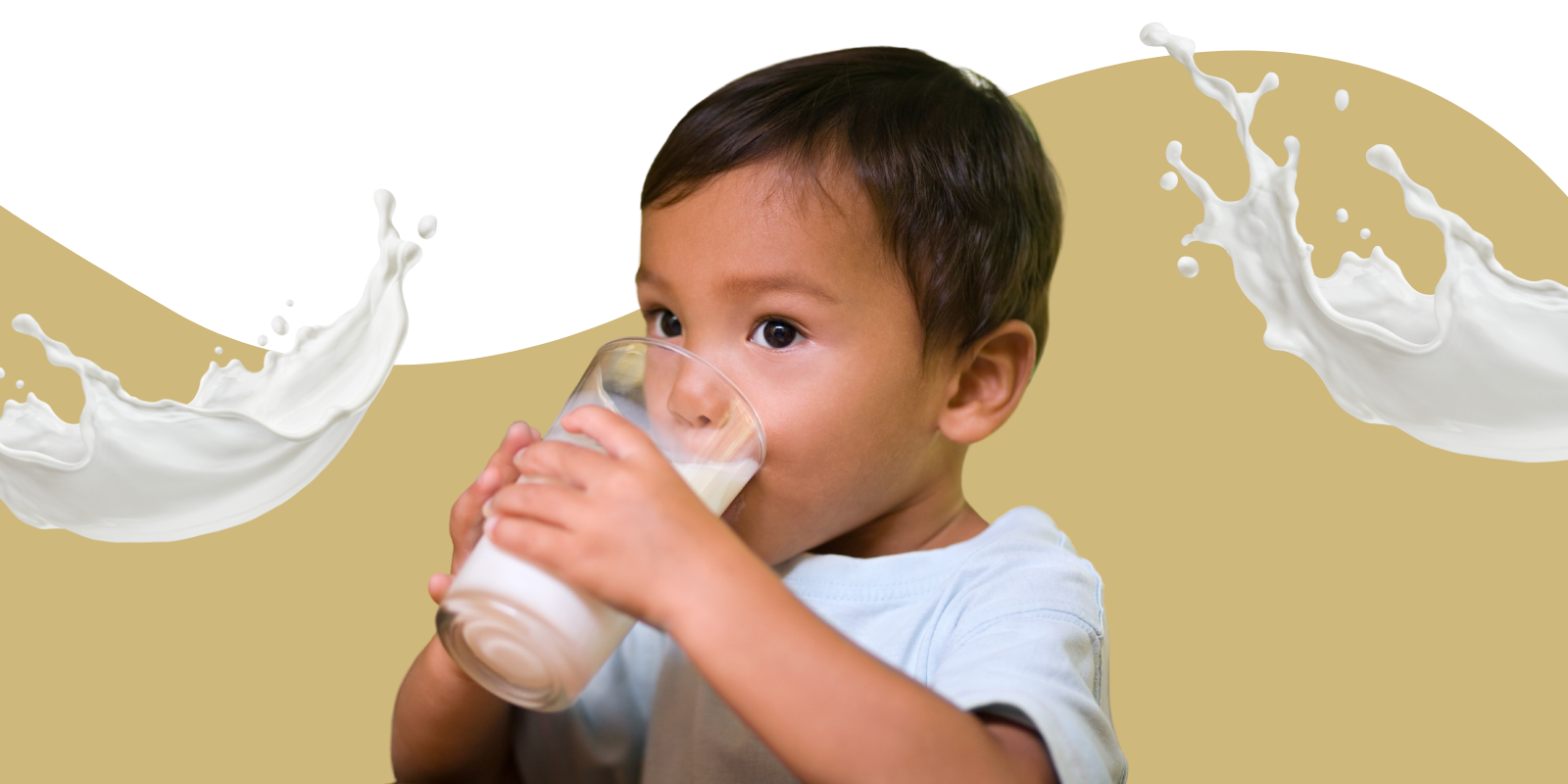What are the types of milk allergies children can experience?
There are two different kinds of cow's milk allergies.
The first is an immediate type that we call IgE-mediated (immunoglobulin E), which is an antibody produced by our immune systems. Symptoms look like a swollen lip or rashes, hives or respiratory impacts that occur within minutes to up to 2 hours after a baby has a bottle or eats a bit of yogurt or other milk containing foods. It’s a rapid reaction.
The second – non-IgE-mediated – typically has a delayed onset. So, a baby drinks milk, then experiences a reaction hours to even days later. This can also include vomiting, constipation, abdominal pain, loose or frequent stools or reflux that lasts between a few hours to a few days. Non-IgE-mediated have several more examples and can be more difficult to pin down because of the delayed reaction.
Does repeated exposure help with outgrowing a milk allergy?
We know that repeated exposure to a food allergen helps you to outgrow it. Here at Children's Hospital Colorado on the CU Anschutz Medical Campus, we have what we call oral immunotherapy clinics.
When it comes to cow's milk, there are two ways we reintroduce it. The first is that we can bring them into the hospital and feed them a drop of cow's milk, eventually building up to half a cup or a cup of cow's milk. Then they continue at home. When they get home, they can consume cow's milk or replace it with cheese, yogurt or other milk-containing foods.
With cow's milk, we have another form of reintroducing milk called the milk ladder. Essentially, we start slowly increasing the amounts of milk a child is exposed to. We start with a cookie, and then they get a muffin, and then a pancake, a waffle, and then some yogurt, some baked cheese and unbaked cheese. Eventually, they have a glass of milk.
|
Venter recently contributed to the DRACMA – Diagnosis and Rationale for Action against Cow's Milk Allergy, managed by the World Allergy Organization, guidelines this year. They were first published in 2010. The evidence and recommendations delineated new changes that depart from previous thinking on allergies:
Breastfeeding individuals no longer need to fully remove allergens from their diets, especially for cow’s milk. It has been shown this isn’t necessary, Venter said.
Complete allergy avoidance isn’t needed, and individual tolerance levels differ. “Some children might be able to have products that label a trace amount of an allergen,” Venter said. “It's difficult to quantify that, but we typically say if you can have 300 milligrams of protein of a food, you can eat anything that contains it or contains traces.”
Baked milk tolerance begins before a tolerance to liquid milk. “Previously, that child would never have had anything with milk in it until they were about five,” said Venter. “Now we are much more proactive about it.”
Children with eczema don’t need to remove milk from their diet. Recent discoveries have shown that eczema may cause a food allergy, but food allergies do not cause eczema. Treatment of eczema with topicals or medication has had better success. “We’ve also found that if you take the allergen out of their diet – most commonly milk – the child can actually develop IgE – immediate type cow's milk allergy — because they're not being exposed to it,” Venter said.
|
In clinical practice in countries such as Ireland and the United Kingdom, they routinely use the milk-ladder process at home in children with IgE-mediated allergy. The latest data from Ireland actually indicates that within 12 months, you can get most children to outgrow their cow's milk allergy, which is fantastic.
The other approach is what you see more in the U.S., particularly here at Children's Colorado.
Due to the differences in insurance and legal framework compared to places like the United Kingdom or Ireland, we do a different approach to the milk ladder. We still bring the kids into the hospital, and slowly move up from a cookie to baked cheese until we get to milk. We're currently applying for funding to actually test the safety of doing this ladder approach at home in children with IgE-mediated cow's milk allergy.
Now children with the milder, delayed-type cow's milk allergy, we do it at home and slowly build up their tolerance over time.
Do breastfeeding parents need to cut cow's milk from their diets if their child has an allergy?
When we talk about these immediate-type allergies – IgE-mediated – it is extremely rare that we will have to ask a mother to take milk out of her diet.
Babies will tolerate the milk in mom's breast milk. When we put them on a formula or a yogurt, that's when they have reactions. Now, it's never zero. A systematic review has recently been published, and Dr. Matthew Greenhawt, one of our allergists, is co-author on it, saying it's extremely rare to see reactions in infants from mom’s milk, but it can happen.
With the non-IgE-mediated allergies, it can depend. Because of how difficult it is to diagnose and to find out which foods are causing the symptom, we don’t have as robust levels of evidence about whether these moms should avoid the milk, and it depends on the case.
The main thing is that if you're going to ask a mother to take milk out of her diet, it's really important that you see a dietician to make sure that her diet is still nutritionally adequate, and that she can cope with taking all these foods out of her diet. If the infant’s symptoms improve on maternal cow’s milk avoidance, we recommend reintroducing cow’s milk into the mother’s diet after a 2-3 week period of avoidance to see if the infant’s symptoms recur.
What have been the recent changes with respect to formula and allergies?
There’s been a lot of changes over the last 20 years.
We didn't have rice hydrolyzed formulas two decades ago. Hydrolyzed formulas are where the formula producer takes the allergen and chops it into small pieces, so the proteins are peptides. Then they ultra-filtrate it as well, both of which result in smaller proteins, meaning there can be less of an allergy response.
We also now have different kinds of cow's milk-based formulas, which are extensively hydrolyzed formulas or partially hydrolyzed, as well as amino acid-based formulas.
In the past 20 years, most guidelines were opposed to the use of soy formula in children under 6 months. People should try to avoid soy unless they can’t find these hydrolyzed formulas, because they're more expensive. Additionally, we’ve actually seen better results for children using the amino acid formulas if they are still reacting to the hydrolyzed formulas because the amino acid formulas support growth much better than soy.
Why are goat milk and other types of mammalian milk not recommended for allergy management?
Goat's milk has a very high cross-reaction with cow’s milk, which means children with a cow’s milk allergy are likely to react to goats milk too. To the immune system, the allergens in goat's milk look very similar to the allergens or the protein in cow's milk.
And while there’s less similarity between cow’s milk and camel milk, we still try not to use any of these mammalian milks because there’s always still some allergen similarity.
The other issue is the nutritional composition in other mammalian milks. For example, buffalo milk has significantly more calories than breast milk or cow’s milk due to the amount of fat. And goat’s milk lacks folic acid, for example.
Does lactose-free milk have the same allergy markers?
Lactose is the sugar in milk, and the immune system reacts to the proteins in milk. Lactose-free milk will be just as allergenic as drinking ordinary cow's milk.
Are there any major nutritional differences between the alternate formula options?
As long as something is labeled an infant formula, they have to comply with FDA guidance and the American Academy of Pediatrics guidance on the nutrients in formulas. That is the case whether it contains cow's milk, it's a hypoallergenic formula, a soy formula or a hypoallergenic formula based on cow's milk or rice milk.
Overall, they’re very similar because they all have to be nutritionally complete to go to market. One other thing to note is that hypoallergenic formulas – whether rice- or cow-milk-based – have to be tolerated by 90% of children with a cow’s milk allergy.
What are the challenges with other plant-based formula options?
Parents should talk to their pediatrician or a dietitian about plant-based beverages. Plant-based formulas are completely unregulated because they are classified as a food, while formula is seen as a medication with stricter standards.
We used to say all these plant-based beverages can be used in children only over the age of 2. Now that guidance and evidence suggests that if the child is over age 1 and is eating a healthy, varied diet, they can have these plant-based products.
However, if there are religious or cultural reasons, a child is a picky eater, or they have multiple allergies that result in them getting over 60% of their calories and protein from formula, they're going to have nutritional deficiency.
This is due to the wide range of ingredient composition, as some will have more protein while others have zero. Same with nutrients like calcium or vitamin D. It becomes really easy for your child to be missing out on key nutrients. The other thing about these plant-based options is they may actually say rice-based, but they add pea protein or flaxseed protein to get the protein up. If the child is allergic to pea or flaxseed, it creates other issues as well. Plant based beverages include e.g. rice, oat, almond, flax, cashew and many other beverages based on plant sources which can be obtained from local retailers and grocers.





